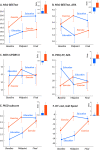Effects of the agility boot camp with cognitive challenge (ABC-C) exercise program for Parkinson's disease
- PMID: 33298934
- PMCID: PMC7608677
- DOI: 10.1038/s41531-020-00132-z
Effects of the agility boot camp with cognitive challenge (ABC-C) exercise program for Parkinson's disease
Abstract
Few exercise interventions practice both gait and balance tasks with cognitive tasks to improve functional mobility in people with PD. We aimed to investigate whether the Agility Boot Camp with Cognitive Challenge (ABC-C), that simultaneously targets both mobility and cognitive function, improves dynamic balance and dual-task gait in individuals with Parkinson's disease (PD). We used a cross-over, single-blind, randomized controlled trial to determine efficacy of the exercise intervention. Eighty-six people with idiopathic PD were randomized into either an exercise (ABC-C)-first or an active, placebo, education-first intervention and then crossed over to the other intervention. Both interventions were carried out in small groups led by a certified exercise trainer (90-min sessions, 3 times a week, for 6 weeks). Outcome measures were assessed Off levodopa at baseline and after the first and second interventions. A linear mixed-effects model tested the treatment effects on the Mini-BESTest for balance, dual-task cost on gait speed, SCOPA-COG, the UPDRS Parts II and III and the PDQ-39. Although no significant treatment effects were observed for the Mini-BESTest, SCOPA-COG or MDS-UPDRS Part III, the ABC-C intervention significantly improved the following outcomes: anticipatory postural adjustment sub-score of the Mini-BESTest (p = 0.004), dual-task cost on gait speed (p = 0.001), MDS-UPDRS Part II score (p = 0.01), PIGD sub-score of MDS-UPDRS Part III (p = 0.02), and the activities of daily living domain of the PDQ-39 (p = 0.003). Participants with more severe motor impairment or more severe cognitive dysfunction improved their total Mini-BESTest scores after exercise. The ABC-C exercise intervention can improve specific balance deficits, cognitive-gait interference, and perceived functional independence and quality of life, especially in participants with more severe PD, but a longer period of intervention may be required to improve global cognitive and motor function.
Conflict of interest statement
This study was supported by NIH (R01AG006457, Horak) and the Department of Veterans Affairs (5I01RX001075, Horak). Also, support from UL1 RR024140 from the National Center for Research Resources (NCRR). Dr. Horak has a significant financial interest in APDM, a company that may have a commercial interest in the results of this research and technology. This potential conflict has been reviewed and managed by OHSU and the VAPORHCS. All other authors declare that the research was conducted in the absence of any commercial or financial relationships that could be construed as a potential conflict of interest.
Figures



References
LinkOut - more resources
Full Text Sources
Research Materials
Miscellaneous

